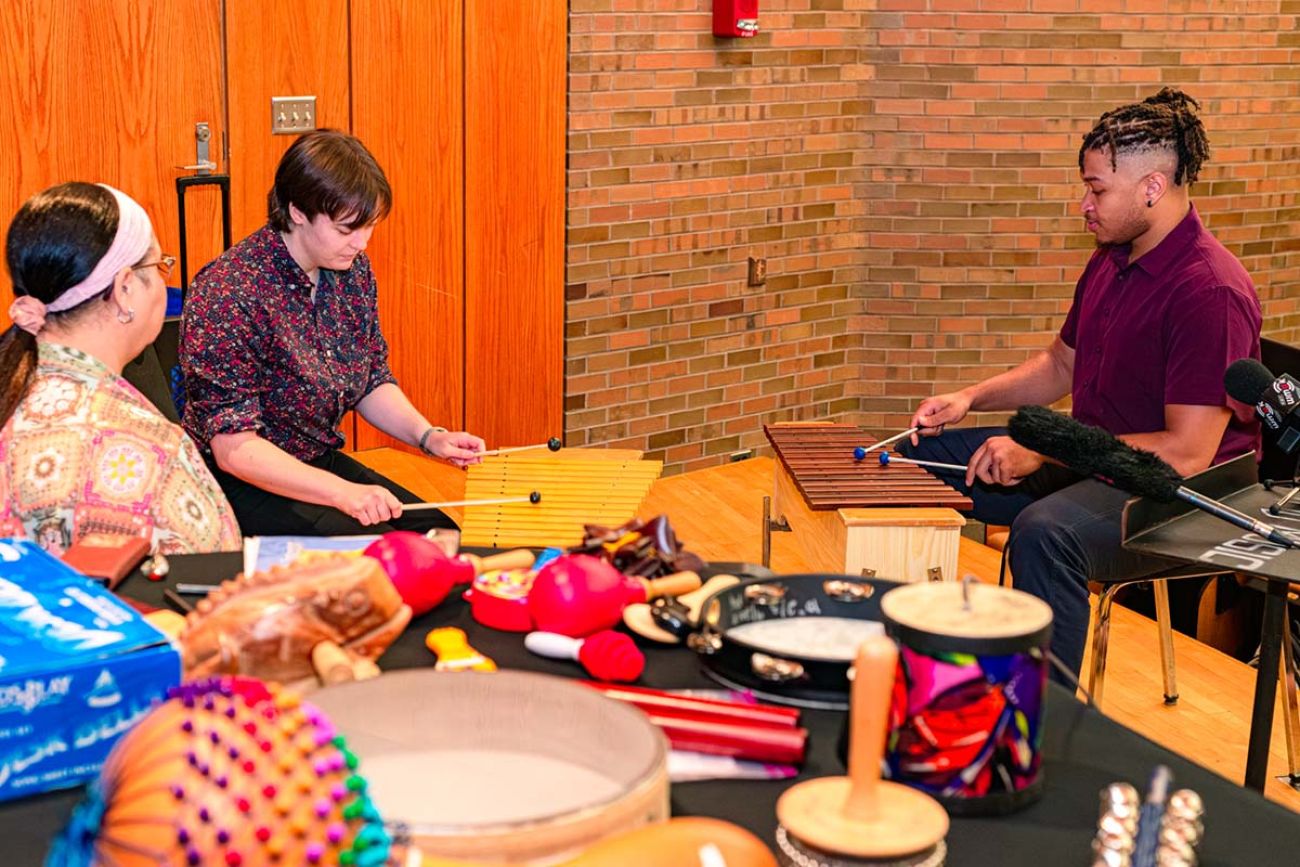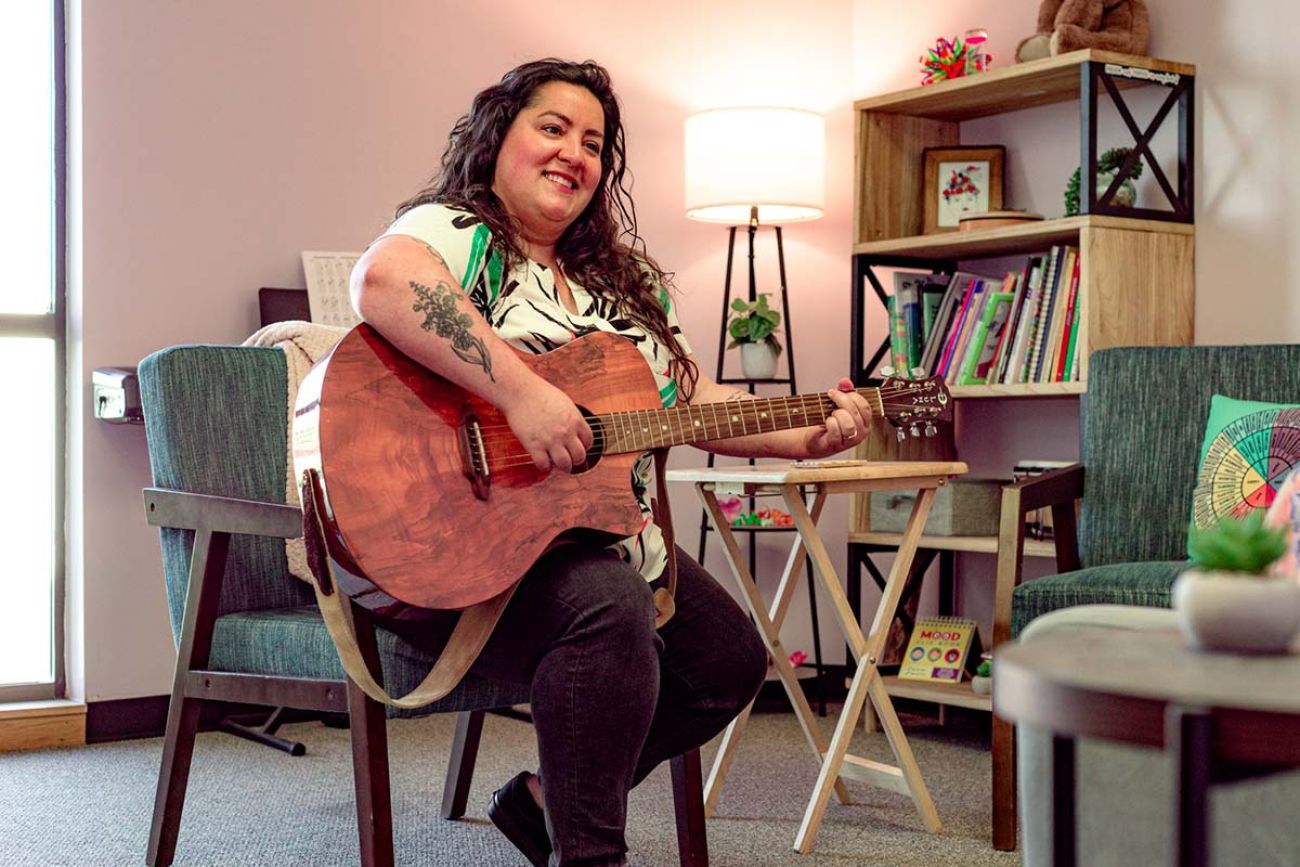For Michigan teens in mental health crisis, music therapy can strike a chord

- Michigan teen mental health issues spiked in pandemic and remains a crisis
- Practitioners say music therapy helps teens identify, verbalize, and study their emotions
- National shortage of adolescent mental health professionals created 'staggering' gap in treatment options
This article is part of a solutions-focused reporting series of Southwest Michigan Journalism Collaborative. The collaborative, a group of 12 regional organizations, is dedicated to strengthening local journalism and reporting on successful responses to social problems in southwest Michigan. This story is funded by the Solutions Journalism Network.
Para leer este articulo en español dale click aqui.
KALAMAZOO — An arm draped over the guitar on her lap, music therapist Hannah Joseph ponders how to begin an impromptu therapy session in her simply decorated Kalamazoo office.
“Ever hear of the 12-bar blues?” she asks, flashing an impish grin.
The rolling chord progression is a staple of music therapy, a field that’s quietly combating a nationwide youth mental health crisis.
With its nonthreatening familiarity and connection to the human brain, music gives therapists a door into teens’ emotions. Therapists use recorded music, hands-on instruments, lyrics analysis, and rhythmic movement to address and ease their patients’ mental health challenges.
Music therapy helps teens identify, verbalize, and study their emotions, empowering them to change the way they act and feel, says Joseph, a clinical social worker and music therapist specializing in therapeutic support for children and adolescents at Kalamazoo Child and Family Counseling.
Music therapists help young people process whatever the music draws out of them, Joseph says.
“Let’s put a name to it,” she says. “Let’s figure out how to understand that part of ourselves a little better. And let’s do that together.”

Music and the brain
Her teen clients don’t come to her to talk about music. They come because they’re hurting, Joseph says.
Teenagers nationwide and in Michigan reported increasing sadness, hopelessness, and suicidal thoughts between 2017 and 2020. The COVID-19 pandemic made those problems exponentially worse. While some signs point to improvement, teens’ mental health remains a national crisis, the CDC says in a new report released in May.
Joseph’s clients tell her they don’t know how to cope with the anxiety, depression, loss of communication skills, and uncertainty the pandemic left behind.
Related:
- Lifesaving doula services expanding for Michigan moms with help of Medicaid
- What a peek into 150 Michigan bank accounts reveals about memory loss
- Desperate for child social workers, Michigan tries new tack: $20K for college
Meanwhile, a national shortage of adolescent mental health professionals has created a “staggering” gap in treatment options for teens, the American Academy of Child and Adolescent Psychiatry reports.
Music therapy could help fill that gap.
Michigan State University launched the world’s first music therapy degree program in 1944. The Certification Board for Music Therapists has since credentialed more than 9,000 music therapists in the U.S. and beyond, about a quarter of whom work with children or adolescents in behavioral health settings.
Music therapy used in conjunction with medical treatment helps people manage pain, improve speech and language skills, lower blood pressure, and more. It has also proven effective in boosting people’s mental health.
Studies show music therapy offers short-term beneficial effects for people with depression and anxiety levels, especially when added to other types of mental health treatment, and has a “significant” positive effect on stress-related symptoms.
Research also supports music therapy’s effectiveness in treating schizophrenia and post-traumatic stress disorder, among other serious mental illnesses.
In any use, the therapy goes beyond merely making a client feel good, says Jennifer Fiore, assistant professor and director of the music therapy program at Western Michigan University.
Unlike regular speech or other sound, music triggers multiple brain areas at once, including those regulating emotion and memory, Fiore explains. Therapists use it strategically to change neural pathways to reach an intended result, whether that be regulating the gait of a Parkinson’s disease patient or tapping into the frontal lobe to release and explore emotion.
WMU’s music therapy students complete coursework in psychology, anatomy, and even dance. In addition to studying their chosen instrument, all students learn to play the guitar and piano and to transpose music.
Fiore recently invited music therapy students to participate in a study analyzing a song she wrote incorporating qualities best suited to stress reduction, according to her research. The students reported a notable decrease in stress after listening to the five-minute song.
Still, Fiore emphasized, music itself is not music therapy.
Music as expression
Music therapists use music to achieve non-musical, patient-specific goals, says Deanna Bush, instructor and coordinator of student clinical experiences in the WMU music therapy program.
During a summer music improvisation class, surrounded by a selection of instruments ranging from beaded shakers to bongo-like tubanos, Bush instructed two students to depict an argument using miniature wooden xylophones. Afterward, the students discussed what they felt during the musical combat.
Do it again, Bush told them, but this time, end the argument calmly.
Actual therapy sessions may include similar tactics to help clients explore real-life situations in the context of music and rhythm. Instruments give even nonmusician clients a new voice with which to speak and be heard, something they may not find in traditional talk therapy, says undergrad student Phoebe Ryckbost.
For Ryckbost and classmate Thomas Valentine, music played an important role in their own mental well-being as teens. Their career path will let them pay that forward to other struggling young people, they say.
“That’s what we’re here for,” Valentine says. “To help bring out the music in people.”
Access and safety cautions
While WMU’s music therapy enrollment is down in recent years, the number of certified music therapists nationwide gradually climbed over the past decade, parallelling increased recognition of music therapy as an effective form of mental health care.
The U.S. Bureau of Labor Statistics projects steady employment growth over the next decade among recreational therapists, the heading under which it places music therapy. Still, potential patients may lack access to a certified music therapist, especially in rural or underserved areas, Bush says.
Cost also thwarts some patients unable to pay out of pocket, as therapy can be expensive and is not always covered by insurance.
As recognition of music therapy grows, insurance companies increasingly cover music therapy sessions deemed medically necessary. Coverage usually requires a doctor’s referral and a documented, goal-directed treatment plan, according to the American Music Therapy Association.
Music therapy is widely considered safe, but therapists must still use caution while treating patients. Music’s association with strong memories and emotional reactions can distress some patients, and instrument-playing could, in theory, lead to injury, the National Center for Complementary and Integrative Health cautions.
A versatile tool
Although music therapy has been in therapists' toolboxes for decades, many still treat it as a new profession or consider it too “fun” to be valid therapy. Knowing this, clinicians continuously advocate for and promote awareness of music therapy as an important option for improving people’s lives, Bush says.
Music therapy can focus on verbal communication, cognition, emotional expression, or sensory or physical needs. It can complement talk therapy and engage parts of the brain other therapies can’t reach, Bush says.
In addition, research indicates incorporating music into mental health care can increase the chance that patients receive treatment because it can carry less stigma than traditional talk therapy.
“We need music therapy because of its versatility,” Bush says. “The more options a person has for healing and personal growth, the better.”;
Getting their words out
Music and teens are a natural match, Joseph says. With disarming humor, she helps clients turn their feelings into songs. Together, they find verses and a melody, then write a bridge to serve as a “hope” piece in the song “to say, hey, let’s talk about moving forward together,” she says.
Guided lyric creation lets clients explore feelings that may otherwise frighten or even elude them. Seeing their own thoughts on paper and hearing them in a song opens emotional doors and makes room for exploring healthy solutions, Joseph says.
If a client comes in disgruntled and refuses to engage, she might shrug agreeably, then ask if it’s OK if she “noodles around” on a personal music project. Before long, the music unlocks conversation and the client gets to verbalize what they didn’t know they needed to say.
“The really wonderful thing about music is it helps you create a space where you can just be,” Joseph says. “Where you can just be a person. Whatever your authentic self is in that moment.”
Humans naturally turn to music to meet their emotional needs. That inclination means Joseph’s clients are already halfway toward healing when they walk in her door, she says. The structure and intentionality of music therapy takes them the rest of the way.
Her tactics may make kids laugh, and her music may help them relax, but the most important facet of her work is helping teens figure out what’s going on inside them and what they can do about it, the therapist says.
“You’ve got to let a kid get their words out, right?” she says.
Meeting them where they are
For music therapist Louie Morand, helping kids get words out means recording hundreds of audio recordings of original music each school year, much of it filled with aching lyrics and hard-pounding bass.
Morand works with court-involved teens in Kalamazoo County. In group therapy sessions, he matches whatever mood the students bring to the session, whether they be rowdy, lethargic, or raging with anger.
“You’ve got to meet them where they are,” Morand says. He yells with the teens or shares in their sadness, and he plays songs that do that, too. Then, he taps the power of music by selecting songs with more regulated tempos and lyrics. The teens’ moods shift as their brains naturally connect with and follow the music, even unconsciously matching their breathing to the music’s rhythm.
A drumming improvisation session — “They love drumsticks,” he says — might lead to a conversation about modulating their behavior to get the consequences they want from the other drummers. Take the music away, “and suddenly, they’re talking about life,” Morand says.
His therapy sessions delve into lyrics of the rap songs the teens admire. He brings subwoofers and high-quality speakers so they can play the music loudly, “so they can feel it in their being.”
Like Joseph, he helps the teens write lyrics, but he takes it another step, using professional mics and his music mixing skills to record the teens performing their own songs. The recordings offer another way to examine their emotions and take ownership of their actions.
“It gives them a platform to have a conversation with themselves,” Morand says. “They get to tell their stories. And that provides that impetus for change.”
With a safe place to speak what’s inside them, to examine it and grow from it, teens engaged in music therapy are better prepared to meet the challenges life will keep throwing at them, Joseph says.
“It doesn’t have to sound good, right?” she says. “As long as there’s a song in your heart, it deserves to be sung.”
See what new members are saying about why they donated to Bridge Michigan:
- “In order for this information to be accurate and unbiased it must be underwritten by its readers, not by special interests.” - Larry S.
- “Not many other media sources report on the topics Bridge does.” - Susan B.
- “Your journalism is outstanding and rare these days.” - Mark S.
If you want to ensure the future of nonpartisan, nonprofit Michigan journalism, please become a member today. You, too, will be asked why you donated and maybe we'll feature your quote next time!








